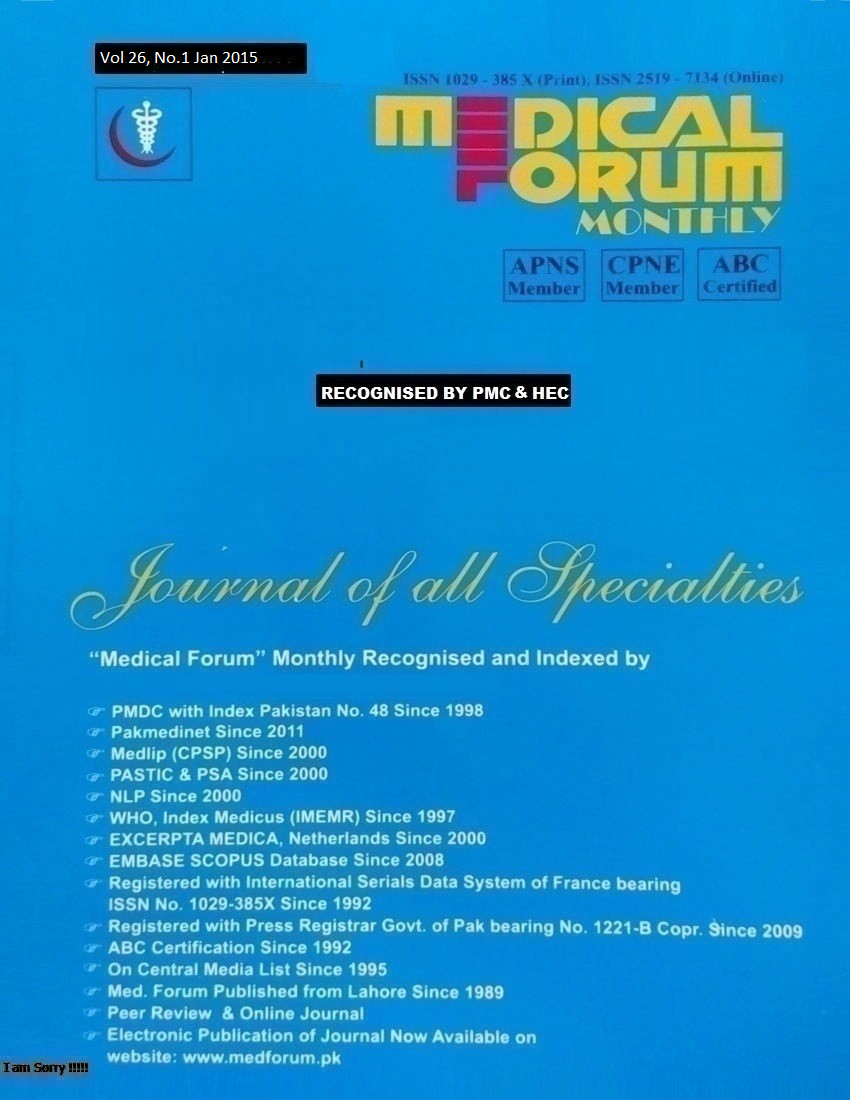
7. Renal Profile in Cases Subjected to Blunt Trauma
1. Zubaida Zain 2. Tariq Azhar 3. Syed Muhammad Zaffar Bukhari 4. Muhammad Iqbal Mughal 5. Abdul Ghani
1. Asstt. Prof. of Forensic Medicine, Shifa College of Medicine, Islamabad 2. Asstt. Prof. of Forensic Medicine, PGMI, Lahore, 3. Prof. of Forensic Medicine, CMC, Lahore, 4. Prof. of Forensic Medicine, CPMC, Lahore,
5. Asstt. Prof. of Forensic Medicine, CPMC, Lahore
ABSTRACT
Objective: To study the occurrence of renal failure in cases subjected to blunt trauma.
Study design: Analytical study.
Place and Duration of Study: This study was carried out at the Medico-legal clinic, Services Hospital, Lahore from January to December, 2007.
Materials and Methods: The study was based upon 50 cases of blunt trauma reporting at Medico-legal clinic, Services Hospital, Lahore. Twenty normal healthy controls were taken for comparison purposes. The cases were clinically examined for presence of evidence of trauma. Urine and blood samples were taken for estimation of blood urea, creatinine, potassium & calcium.
Results: There were 47 males (94 %) and 3 females (6 %). The age of the subjects ranged between 18-70 years with mean of 30.9 ±12.34, maximum number (62 %) below the age of 30. The injuries found were abrasions / bruises in 45 cases (90 %), lacerated wounds in 5 cases (10 %) . In most of the cases (40%) injuries were distributed in more than one body region. As single area involvement the head and face area was affected in one case (2 %), chest in 4 cases (8 %) and limbs in 25 cases (50 %). The most commonly involved areas were buttocks, thighs, back of chest. Twenty nine cases (58 %) reported for examination within 24 hours. Thirteen cases (26 %) reported between 24-48 hours and 8 cases (16 %) reported between 48-72 hours after being traumatized.
Urine Examination showed yellow colour in 44 cases (88%) and brownish red in 6 cases (12 %). Specific gravity ranged between 1010-1030 with mean of 1020.6 ± 6.59. It was between 1010-1019 in 14 cases(28%), 1020-1029 in 27 cases (54%) and 1030-1039 in 9 cases(18%). pH ranged between 5 – 8 with mean of 5.8 ± 0.75. It was between 5 – 5.9 in 7 cases(14%) , between 6.0 – 6.9 in 27 cases(54%) , between 7.0 – 7.9 in 14 cases(28%) and 8.0 & above in 2 case(4%). In control group it ranged between 6.0 – 7.0 with mean of 6.4 ± 0.50. Blood was positive in 7 cases(14%), and negative in 43 cases(86%). Microscopic Examination of urinary sediment showed pus cells 0 – 5 /HPF in 35 cases (70%), and above 5/PHF in 15 cases (30%). The red blood cells were present in 15 cases (30%). Calcium oxlate crystals were found in 39 cases (78%), triple phosphate in 5 cases (10%). In 6 cases (12%) no crystals were found. The cellular casts were present in 6 cases (12%).
In blood examination blood urea ranged between 15.5 – 86.0 mg/dl with a mean of 43.54 ± 15.06 . The blood urea was above reference range in 7 cases (14 %). Blood Creatinine ranged between 0.5 – 2.6 mg/dl with mean of 0.97 ± 0.47. The raised blood creatinine was found in 7 cases (14%) . These cases are the same cases which have raised blood urea. Serum Potassium ranged between 3.2 – 5.9 mmol/dl with mean of 4.45 and S.D. 0.78. It is above reference range in 9 cases (18%). In cases with raised blood urea and creatinine it was raised in all cases. Serum Calcium ranged between 5.6 – 10.74 with mean of 8.84 ± 1.01. The hypocalcaemia was seen in 25 cases (50%). In the cases with raised blood urea and creatinine the calcium was low in all cases. In our study 14% cases have shown the evidence of renal function derangement.
Conclusion: The cases subjected to blunt trauma are at threat to develop renal failure particularly in cases with dehydration and acidosis.
Key Words: blunt trauma, renal failure, myoglobinuria, rhabdomyolysis
Citation of article: Zain Z, Azhar T, Bukhari SMZ, Mughal MI, Ghani A. Renal Profile in Cases Subjected to
Blunt Trauma. Med Forum 2015;26(1):24-28.
